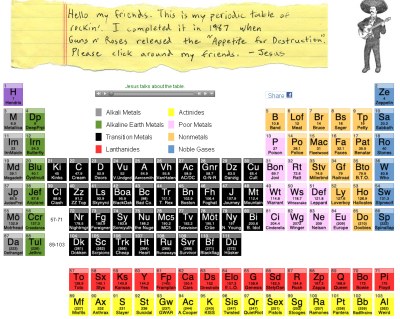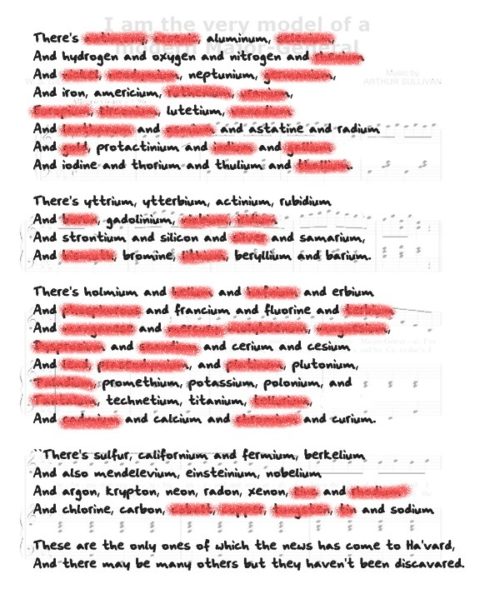 For the chemical class of 1999…
For the chemical class of 1999…
More than a decade ago, American journalist Mary Schmich offered her advice to youth in the form of a spoof graduation speech centering around the crucial maxim ‘wear sunscreen‘, the article was published in the Chicago Tribune. As is the way with these things it struck a chord among the literati and quickly spread to the Internet through the usenet and discussion groups. [Of course, today, it would be simply tagged linkbait or tweeted and would be said to have gone viral.]
But at the time, somewhere along the wire, Schmich’s text was attributed to American cult novelist Kurt Vonnegut as a student prank and the ‘wear sunscreen’ speech somehow gained its own cult status.
Then, Australian film director Baz Luhrmann (Romeo & Juliet, Strictly Ballroom, Moulin Rouge) picking up on the Vonnegut vibe, put the words to music and at the beginning of June the ‘song’ was released as a single in the UK…just in time for countless graduations around the academic world. At the time, I thought chemists probably needed their own speech…but somehow ‘wear sunscreen’ was not quite right…so…
Wear goggles…
If I could offer you only one tip for your career, goggles would be it. The long-term benefits of goggles have been proven scientifically, whereas my other advice has no basis more reliable than my own ramblings. This advice is dispensed below.
Enjoy the size and power of your first grant. You will not understand just how small it is until the next bill. But, in 20 years, you’ll look back at all those lost grant applications and recall with fondness the possibilities that lay before you and how little cash you had to fulfil them.
You do not have as many pens in your breast pocket as others imagine.
Don’t worry about that overnight experiment. Well, worry, but know that worrying is as effective as trying to solve a crystal structure by chewing the crystals first. The real troubles in your lab are likely to be things that never crossed your worried mind, such as lab technicians smoking over open ether bottles at 4 pm on a lazy Tuesday.
Do one experiment every day that scares you, such as a Grignard reaction in the bath.
Distil.
Don’t waste other people’s reagents. Don’t put up with people who waste yours.
Evaporate.
Don’t waste your time on jealousy. Sometimes you publish first, sometimes you don’t. The experiment is long and, in the end, it’s only chemistry.
Remember the acceptance letters you receive. Forget the rejections. If you succeed in doing this, tell your older colleagues how.
Keep your old lab-books. Throw away your old COSHH forms.
Re-crystallise.
Don’t feel guilty if you don’t know what you want to do in the lab. Some of the most interesting chemists around didn’t know at 22 what they wanted to do with their labs. Some of the most interesting 40-year-olds still don’t.
Get plenty of acetone. That chocolate stain might just come out of your lab-coat.
Be kind to your reaction flasks. You’ll miss them when they’re gone and there’s no budget for new glassware till next semester.
Maybe you’ll synthesize, maybe you won’t. Maybe you’ll have by-products, maybe you won’t. Maybe you’ll become an accountant at 40, after all, maybe you’ll collect your Nobel Prize on your 75th birthday. Whatever you do, don’t congratulate yourself too much, or berate yourself either. Your yields are half chance. So are those everybody else.
Enjoy your Bunsen. Use it every way you can. Don’t be afraid of it or of what other people think of it. Don’t worry about it’s size, they are all the same. Remember, it’s the greatest instrument you’ll ever own.
Analyse, even if you have nowhere to do it but the back office.
Read the literature, even if you don’t follow it.
Do not read glossy science magazines. They will only make your results look feeble and pointless and make you resent journalistic hype.
Get to know your mentors. You never know when they’ll be gone for good.
Be nice to your lab-mates. They’re your best alibi when things go wrong but the people least likely to remember where you put your spatula.
Understand that reactions come and go, but a precious few will go to completion. Work hard to bridge the gaps in geography and disciplines, the tighter funds get, the more interdisciplinary research is likely to complete a successful grant application.
Work in industry once, but leave before it makes you hard. Work at the University of Utopia once, but leave before it makes you soft.
React.
Accept certain inalienable truths: Reaction yields will fall, enantiomeric excesses will dwindle. Referees will criticise. You, too, will get old. And when you do, you’ll fantasise that when you were young, yields approached 100%, compounds were optically pure, referees were always fair and post-grads respected their supervisors.
Respect your supervisor.
Don’t expect anyone to support you, except funding councils, industrial collaborators and your institute. Maybe you have a patent. Maybe you’ll have a wealthy benefactor. But you never know when either one might run out.
Don’t mess too much with your hair – unless you work with sulphur or selenium – or by the time you’re 40 it will look you did, already.
Be careful whose advice you buy, but be patient with those who supply it. Advice is a form of nostalgia. Dispensing it is a way of distilling the past, evaporating off the solvent, recrystallising the product and recycling it for more than it’s worth.
But trust me on the goggles.
 With a nod and a wink to Mary Schmich of The Chicago Tribune who wrote an article entitled ADVICE, LIKE YOUTH, PROBABLY JUST WASTED ON THE YOUNG, which has recently been resurrected as a pop ‘song’ by Baz Luhrmann under the title Everybody’s Free (To Wear Sunscreen)
With a nod and a wink to Mary Schmich of The Chicago Tribune who wrote an article entitled ADVICE, LIKE YOUTH, PROBABLY JUST WASTED ON THE YOUNG, which has recently been resurrected as a pop ‘song’ by Baz Luhrmann under the title Everybody’s Free (To Wear Sunscreen)
Incidentally, if this seems familiar, I first published it in my weekly Catalyst column on the original ChemWeb.com back in the spring of 1999, at the time Lurhmann had the hit record.
Did you survive the decade in the lab? Find out who almost didn’t in Monday’s Sciencebase post on Stupid Science.


 Yesterday, I mentioned the rather serious issue of periodic threats, materials security, and dwindling elemental resources. I rather flippantly suggested that someone ought to do a cover version of the classic
Yesterday, I mentioned the rather serious issue of periodic threats, materials security, and dwindling elemental resources. I rather flippantly suggested that someone ought to do a cover version of the classic  But, was it all for nothing? Within another generation the notion of digital audio had been compressed using the audio equivalent of the lossy image format jpeg and music fans were listening on pocket devices or watching Youtube clips with embedded music on poor-quality computer speakers and really not caring either way, whether the sound was great or not.
But, was it all for nothing? Within another generation the notion of digital audio had been compressed using the audio equivalent of the lossy image format jpeg and music fans were listening on pocket devices or watching Youtube clips with embedded music on poor-quality computer speakers and really not caring either way, whether the sound was great or not.
 For the chemical class of 1999…
For the chemical class of 1999… With a nod and a wink to Mary Schmich of The Chicago Tribune who wrote an article entitled ADVICE, LIKE YOUTH, PROBABLY JUST WASTED ON THE YOUNG, which has recently been resurrected as a pop ‘song’ by Baz Luhrmann under the title Everybody’s Free (To Wear Sunscreen)
With a nod and a wink to Mary Schmich of The Chicago Tribune who wrote an article entitled ADVICE, LIKE YOUTH, PROBABLY JUST WASTED ON THE YOUNG, which has recently been resurrected as a pop ‘song’ by Baz Luhrmann under the title Everybody’s Free (To Wear Sunscreen) I’ve let quite a pile of review books accumulate on my desk again as well as a couple of non-book oddities, so here’s a quick round-up.
I’ve let quite a pile of review books accumulate on my desk again as well as a couple of non-book oddities, so here’s a quick round-up.